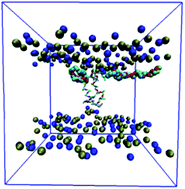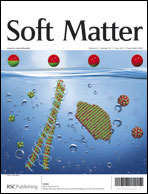Interactions of PEO–PPO–PEO block copolymers with lipid membranes: a computational and experimental study linking membrane lysis with polymer structure†
Abstract
Poly(ethylene oxide) (PEO) and poly(propylene oxide) (PPO) block co-polymers (PEO–PPO–PEO, sold as Pluronics, Poloxamers, Tetronics) are a widely used class of amphiphilic materials for different biological applications. In fact for certain members of the Pluronics series, the interactions of block segments with living cells alter the lipid membrane properties and facilitate the permeation of drugs. A fuller understanding of the molecular mechanisms underpinning these interactions is essential for ensuring their safety and efficacy in biomedical applications and to inform the design of new amphiphilic copolymers for potential use in a clinical setting. In this paper, by means of atomistic molecular dynamics simulations and membrane lysis assays, we investigate the relationship between the molecular conformations of a subset of the Pluronic copolymers (L31, L61, L62 and L64) and their haemolytic activity. Our computational studies suggest that the hydrophilic blocks in these copolymers interact with the polar head groups of lipid molecules, resulting in a predicted modification of the structure of the membranes. Parallel membrane lysis assays in human erythrocytes indicate differences in the rates of haemolysis, as a result of incubation with these polymers, that correlate well with the predicted interactions from the atomistic simulations. The computational data thus provide a putative mechanism to rationalize the available experimental data on membrane lysis by these copolymers and quantitatively agree with haemoglobin release endpoints measured when copolymers with the same molecular weight and structure as of those modelled are incubated with erythrocytes. The data further suggest some new structure–function relationships at the nanoscale that are likely to be of importance in determining the biological activity of these otherwise inert copolymers.

- This article is part of the themed collection: Interaction of nano-objects with lipid membranes

 Please wait while we load your content...
Please wait while we load your content...